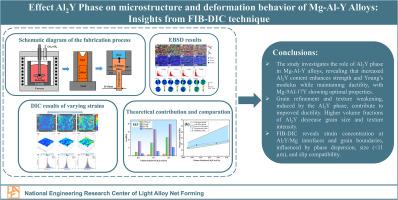Al2Y相对Mg-Al-Y合金组织和变形行为的影响:来自FIB-DIC技术的见解
IF 13.8
1区 材料科学
Q1 METALLURGY & METALLURGICAL ENGINEERING
引用次数: 0
摘要
采用机械搅拌铸造和热挤压法制备了Al2Y相体积分数不同的Mg-3Al-5Y、Mg-6Al-11Y、Mg-9Al-17Y和Mg-11Al-21Y (wt.%)合金。采用聚焦离子束-数字图像相关(FIB-DIC)技术研究了Al2Y相对Mg-Al-Y合金显微组织和变形行为的影响。结果表明:随着Al2Y相体积分数的增加,Mg-Al-Y合金的强度不断提高,这主要归因于热膨胀系数(CTE)强化机制;由于Al2Y相的高模量,杨氏模量也增加了,模量的增加更符合Reuss模型的预测。值得注意的是,Mg-9Al-17Y合金在屈服强度(202.4 MPa)、杨氏模量(51.5 GPa)和延展性(7 %)方面达到了最佳组合。FIB-DIC技术突出了Al2Y/Mg基体界面和晶界处的应变集中,其中应变相容性受到相邻晶粒取向和相界面失配的影响。此外,Al2Y相的尺寸、分散和分布在应变调节中起着至关重要的作用。该研究为高性能镁合金的设计提供了有价值的见解。本文章由计算机程序翻译,如有差异,请以英文原文为准。

Effect of Al2Y phase on microstructure and deformation behavior of Mg-Al-Y Alloys: Insights from FIB-DIC technique
In the present work, four Mg-3Al-5Y, Mg-6Al-11Y, Mg-9Al-17Y, and Mg-11Al-21Y (wt.%) alloys, with different volume fractions of Al2Y phase, were fabricated by mechanical stirring casting and hot extrusion. The effect of Al2Y phase on the microstructure and deformation behavior of Mg-Al-Y alloys was investigated using the focused ion beam–digital image correlation (FIB-DIC) technique. The results show that as the volume fraction of the Al2Y phase increases, the strength of the Mg-Al-Y alloys continuously improves, which is primarily attributed to the coefficient of thermal expansion (CTE) strengthening mechanism. The Young’s modulus also increases, owing to the high modulus of the Al2Y phase, and the increase in modulus is more consistent with the prediction of the Reuss model. Notably, the Mg-9Al-17Y alloy achieves an optimal combination of yield strength (202.4 MPa), Young’s modulus (51.5 GPa), and ductility (7 %). The FIB-DIC technique highlights strain concentration at the Al2Y/Mg matrix interfaces and grain boundaries, where strain compatibility is influenced by adjacent grain orientations and phase interfaces mismatch. Additionally, the size, dispersion, and distribution of Al2Y phases play a crucial role in strain accommodation. This study provides valuable insights for the design of high-performance magnesium alloys with enhanced mechanical properties.
求助全文
通过发布文献求助,成功后即可免费获取论文全文。
去求助
来源期刊

Journal of Magnesium and Alloys
Engineering-Mechanics of Materials
CiteScore
20.20
自引率
14.80%
发文量
52
审稿时长
59 days
期刊介绍:
The Journal of Magnesium and Alloys serves as a global platform for both theoretical and experimental studies in magnesium science and engineering. It welcomes submissions investigating various scientific and engineering factors impacting the metallurgy, processing, microstructure, properties, and applications of magnesium and alloys. The journal covers all aspects of magnesium and alloy research, including raw materials, alloy casting, extrusion and deformation, corrosion and surface treatment, joining and machining, simulation and modeling, microstructure evolution and mechanical properties, new alloy development, magnesium-based composites, bio-materials and energy materials, applications, and recycling.
 求助内容:
求助内容: 应助结果提醒方式:
应助结果提醒方式:


